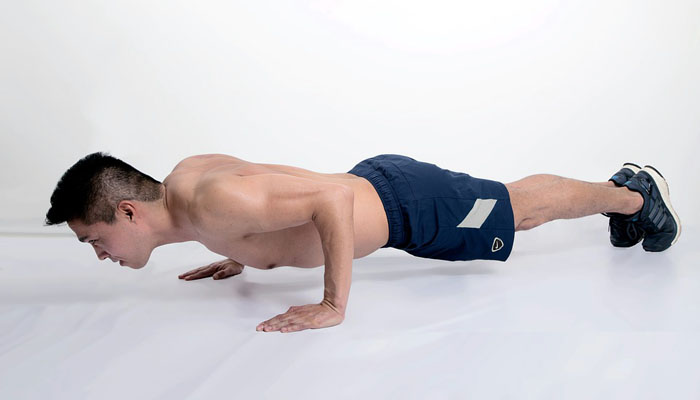The Isometric Push-Up Hold Test requires the participants to hold a lowered 'down' push-up position for as long as possible. This is different from the Brockport assessment Isometric Push-Up Test in which the 'up' position is held. See the similar fitness tests the Plank Fitness Test and Side Ramp Tests. There are also several other push-up tests.
test purpose: to measure maximum strength endurance of the chest and arm muscles, as well as core body strength.
equipment required: flat and clean surface, stopwatch, recording sheets, pen.
pre-test: Explain the test procedures to the subject, and demonstrate the correct technique. Perform screening of health risks and obtain informed consent. Prepare forms and record basic information such as age, height, body weight, gender and test conditions. Perform a standard warm-up. See more details of pre-test procedures.
procedure: The participant assumes the standard starting position for a push-up — the hands directly below the shoulders, the arms extended, the whole body in a straight line, and the toes touching the floor or mat. The chest is lowered until the arms are at a right angle (90 degrees), the stopwatch is started, and the body is held in this position for as long as possible. The test ends as soon as the subject is unable to maintain the correct position (any movements such as bending, sagging, or swaying).

scoring: record the length of time the correct position was held, to the nearest second.
target population: this test is used by those wanting to improve their push-up strength. It is not a commonly used test.
notes: Breath holding should be avoided - it should be emphasised to continuously breathe throughout the test.
Similar Tests
- Isometric Push-Up Test — hold the raised push-up position for up to 40 seconds.
- Plank Fitness Test — hold the plank position for as long as you can.
- Side Ramp Fitness Test — hold the side-ramp position for as long as you can.
- Trunk Stability Push-Up Test — push up from the ground while keeping the body straight with no sagging.
- Seated Push-up — extend the arms and raise the body out of a chair, and hold this position for as long as possible.
- Wall Squat — hold a squatting position against a wall for as long as you can.
- Isometric Back Strength
- Isometric Leg Strength
- Isometric Leg Extension (Groningen)
Related Pages
- About Push-Up Fitness Testing
- About the Brockport Test Battery — health-related tests of physical fitness for use with young people with disabilities.
- Other Strength Tests
- About the Push-Up Fitness Exercise


 Current Events
Current Events